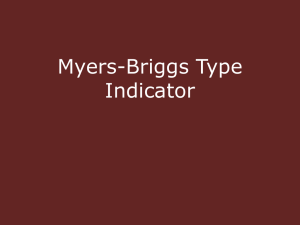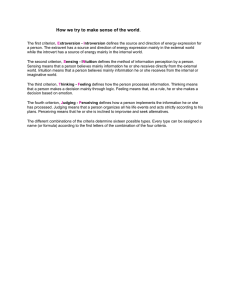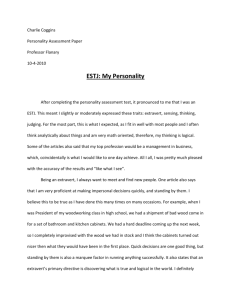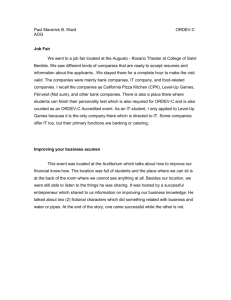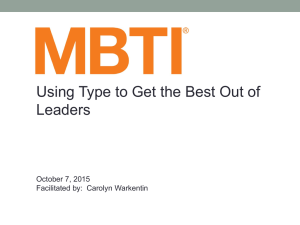Why Does it Matter?
advertisement
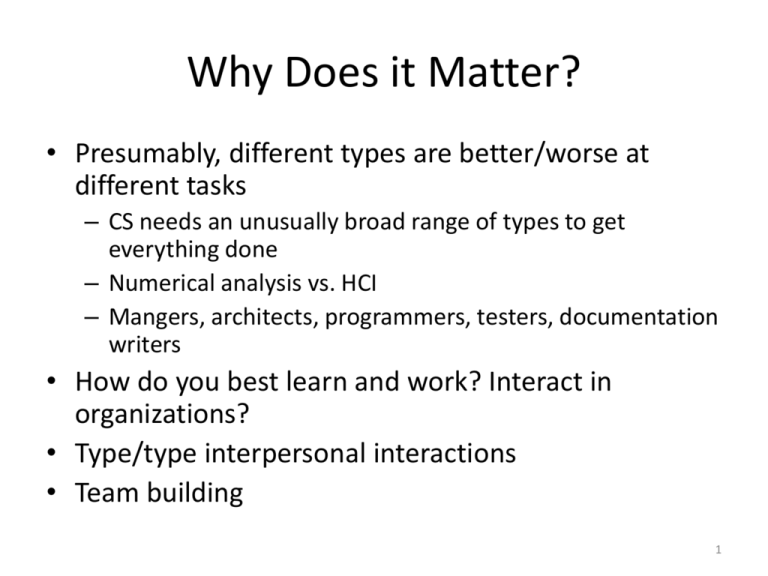
Why Does it Matter? • Presumably, different types are better/worse at different tasks – CS needs an unusually broad range of types to get everything done – Numerical analysis vs. HCI – Mangers, architects, programmers, testers, documentation writers • How do you best learn and work? Interact in organizations? • Type/type interpersonal interactions • Team building 1 What Type Am I? • Depending on which test you take/ your current mood, you might end up assigned to different categories on different attempts. • Testers often defer to the person on “best fit” category. • Be careful when reading the descriptions – They tend to be general – They tend to be a bit flattering (which category type is for scatterbrained people? For couch potatoes?) – In general, readers tend to agree with any generic assignment that they are given (Forer effect) 2 Four Dichotomies • The words used for the poles on each of the four dichotomies have technical meanings – You can’t interpret what these mean using the everyday definitions of the words – A person isn’t “more judgmental” or “less perceptive” in these words’ everyday meaning 3 Introvert/Extravert [Attitude] • Defines the source and direction of energy expression for a person. – Extravert has a source and direction of energy expression mainly in the external world. Act/reflect/act. Energy/motivation decline with inactivity. – Introvert has a source of energy mainly in the internal world. Reflect/act/reflect. Needs downtime after action to reflect. 4 Introvert/Extravert (Cont) • These meanings are different from common use. • You reflect before you act, and you might need plenty of “reflect time” after acting, but can still enjoy and interact at a party without being shy • An extravert might draw strength from acting rather than from reflecting, but that doesn’t tell us whether he is a “loud” person or not 5 Sensing/iNtuition [Function] • Defines the method of information perception – Sensing means that a person believes mainly information received directly from the external world – tangible and concrete facts drive patterns. More present oriented. Methodical, precise. – Intuition means that a person believes mainly information he or she receives from inside (books, memories) – how facts fit into the pattern. More future oriented. “Flash of insight.” Dislikes routine. • Says what you prefer to focus on – Often need to use the opposite to “check” 6 Thinking/Feeling [Function] • Defines how the person processes information (decision making). Both strive to make rational decisions. Both can be practiced/strengthened. – Thinking means that a person makes a decision mainly through logic/reason. More detached, impersonal. – Feeling means that, as a rule, he or she makes a decision holistically, including emotion. Look at from “inside” and strive to reach balance/harmony/ consensus with values. More personal, subjective. – “Heart vs. Head” • You will trust your preferred approach better, but most have some ability to work in either mode. 7 Judging/Perceiving [Lifestyle] • Defines how a person implements the information he or she has processed. – Judging means that a person organizes all his life events and acts strictly according to his plans. Prefers things decided. Prefers things on time. Might seem inflexible. – Perceiving means that he or she is inclined to improvise and seek alternatives. Likes to leave things open. More likely to push deadlines. 8 MB Example • INTJ – Strength in each dimension (ex: mild I vs. E, mild N vs. S, moderate-strong T, strong J) – Occurrence in population (this one is 1-2%) • Dr. Onufriev: tends toward INTP, but on any given day/test might register as ENTP. 9 What is the CS Personality? • What is the “public perception” of CS? • What is your perception? 11 Type Distribution Name Class pop General pop Weight (Count) ISTJ 19.8% 11.6% 13.5(19) ISFJ 1% 13.8% 1(1) INFJ 9.3% 1.5% 6(9) INTJ 13.54% 2.1% 10(13) ISTP 5.2% 5.4% 2.5(5) ISFP 3.1% 8.8% 2(3) INFP 9.3% 4.4% 6(9) INTP 9.4% 3.3% 6(9) ESTP 7.3% 4.3% 4(7) ESFP 3.1% 8.5% 2(3) ENFP 7.3% 8.1% 5(7) ENTP 8.3% 3.2% 5(8) ESTJ 17.7% 8.7% 11.3(17) ESFJ 5.2% 12.3% 2.5(5) ENFJ 7.3% 2.4% 4(7) ENTJ 14.6% 1.8% 8.16(14) 12 Fall 2008 Class Preferences Fall 2007 E: 42 (48) I: 41 (47) E: 10.5 (13) I: 22.5 (29) N: 50 (62) S: 39 (51) N: 20 (26) S: 13 (16) F: 28 (35) T: 60(65) F: 7.5 (10) T: 25.5(32) J: 56 (62) P: 32 (40) J: 21.5 (28) P: 11.5 (14) General Engineering E/I 70/30 33/67 N/S 30/70 47/53 J/P 50/50 61/39 F/T 50/50 26/74 F/T: Male 40/60 23/77 F/T: Female 60/40 39/61 13 Relevance to Education • Different types prefer various teaching/testing styles – – – – Sensing and Judging types prefer memorization and recall iNtuition types prefer hypothesis/essay Most in population are sensing Most faculty are intuition • Engineering students are split evenly N/S, but these groups have different needs 14 Putting the theory to use: selecting group leaders. What is the best personality type for the position? E (S/N) (T/F) J
